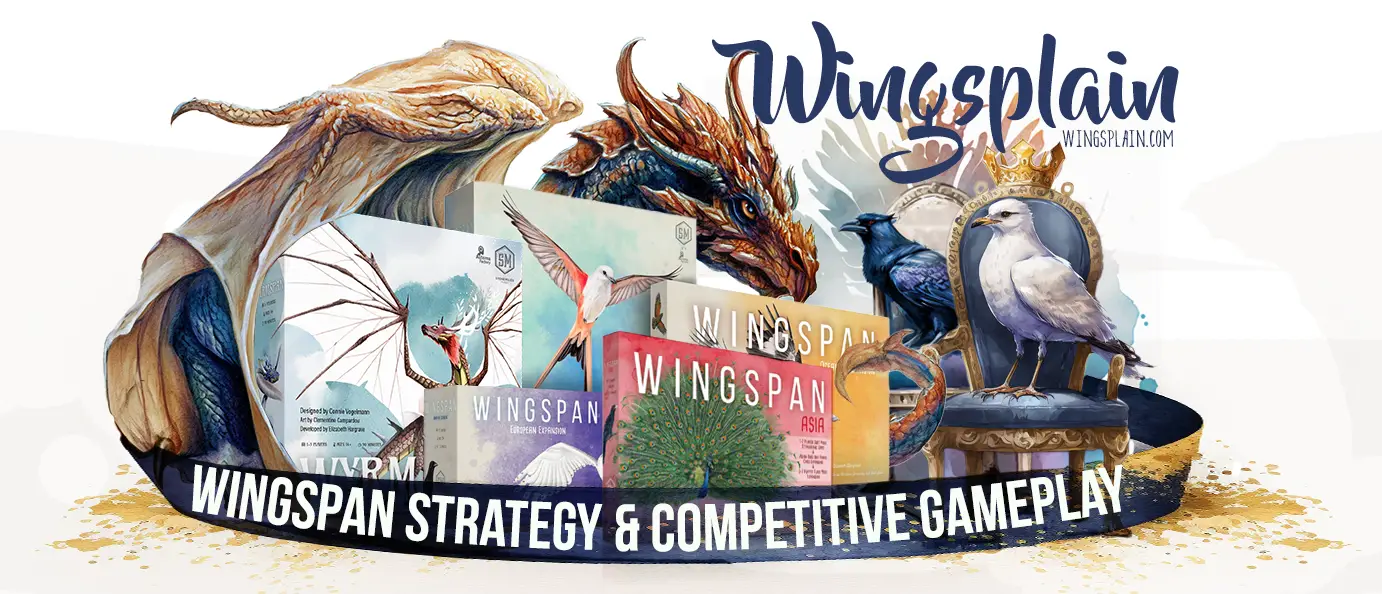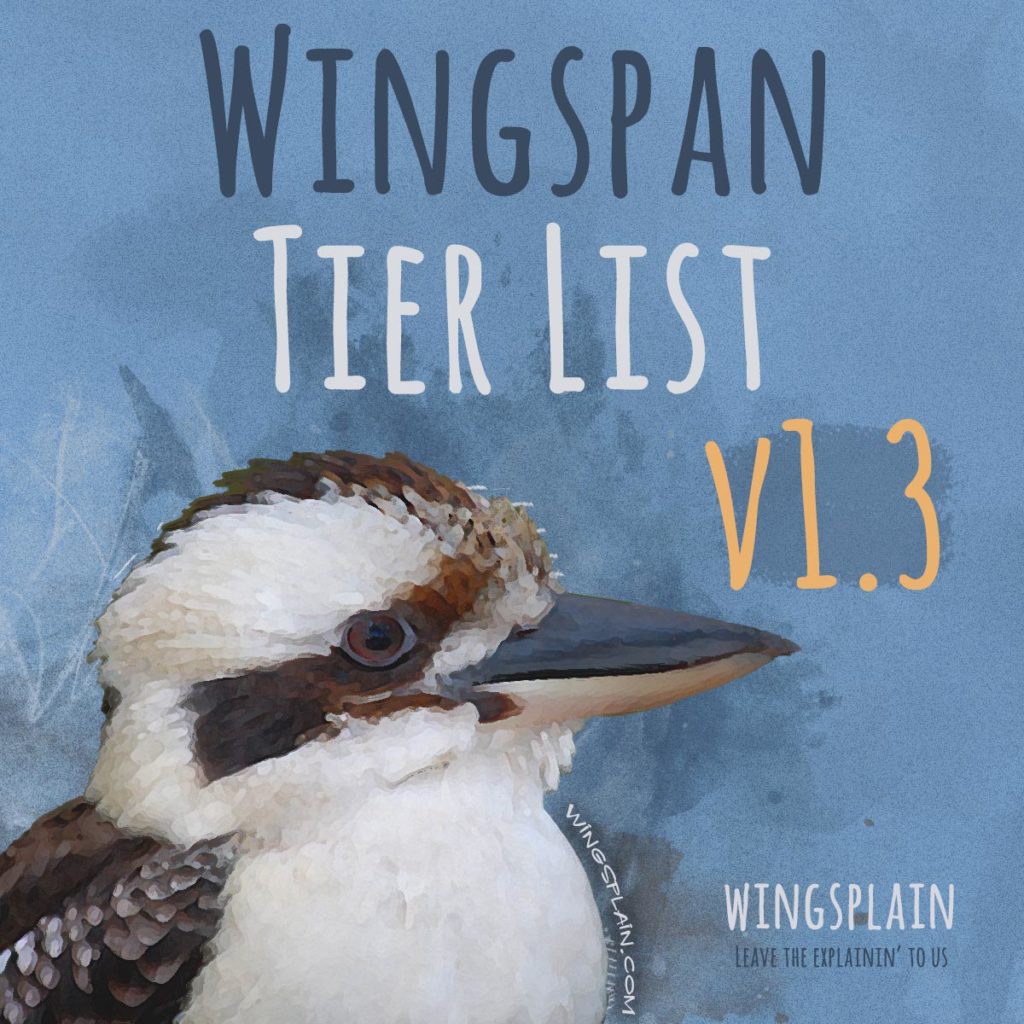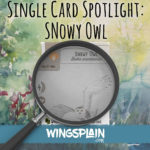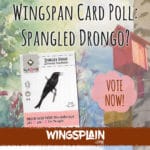In version 1.3 of the Wingspan Card Tier List, I’ve moved 60 birds down the tier list in some capacity. As Oceania sets in and takes root in our home metagame, we’ve observed that certain food-generating birds make less of an impact. This is due to the improved Forest, the wild nature of Nectar, and the higher number of “sharing” birds introduced in Oceania.
“Big point birds” mostly dropped down into Tier 4. Most of these birds don’t have an especially useful power and their primary use is to be dropped as a high point activation when the timing is right.
Migrating birds migrated down the list to varying degrees. We find that their power is generally less useful/desirable in the Oceania metagame.
“Tuck/Draw” birds have moved down the list. We’ve found that they are making less of an impact compared to “Tuck/Lay” birds (which score two points per activation) in the Oceania metagame. This is mostly due to the Grassland’s reduced ability to produce eggs in the early stages of the game, increasing the value of birds that produce eggs. Furthermore, with the increased prevalence of food, playing birds can often be better at scoring points than basic tucking engines over the long haul.
Changes:
- Tier titles removed from some tiers. The titles of “Average” and “Above Average” were causing some confusion related to the real mathematical average distribution of cards vs the subjective distribution.
- Removed T4 floor on the power “When Played: Draw two new bonus cards and keep one.”
- Removed the T2 Floor on “Drawing two cards from the forest”. This was specifically in place for Wood Duck which has moved down the tier list.
- Removed the T3 floor for 8 or 9 point birds.
Forster’s Tern
T3 to T4
Correcting an oversight. This is essentially the same card as Black Tern, a T4 card.
American Coot
T2 to T3
As my home post OE metagame evolves, “Tuck/Draw” birds seem to be making less of an impact than “Tuck/Lay” birds do. Makes a great egg bank. Moderate food cost with Wild flexibility.
Barn Swallow
T2 to T3
As my home post OE metagame evolves, “Tuck/Draw” birds seem to be making less of an impact than “Tuck/Lay” birds do. Three egg star nest and a cheap food cost are a plus.
Belted Kingfisher
T2 to T3
This bird is mostly about being an egg bank with a star nest. Its power can be hit or miss but can be handy under certain circumstances. 50% wild food cost and 4 VP make this a solid play.
Blue-Gray Gnatcatcher
T2 to T4
Food is easier to get in the OE metagame which lessens the value of this archetype of bird.
House Finch
T2 to T3
As my home post OE metagame evolves, “Tuck/Draw” birds seem to be making less of an impact than “Tuck/Lay” birds do. A great egg bank that can be dropped in any habitat.
Sulphur Crested Cockatoo
T2 to T4
Restricted to the Forest. It’s difficult to tuck cards from the forest. Gives nectar to all players from the forest. Getting this nectar yourself isn’t as impactful as it is an “in habitat” resource. Solid six points for two food. Small two-egg nest. Food is easier to get in the OE metagame.
Tree Swallow
T2 to T4
“Tuck/Draw” birds make less of an impact than “Tuck/Lay” birds do in the OE metagame. General qualities don’t set it apart from other birds in the archetype.
Violet Green Swallow
T2 to T4
“Tuck/Draw” birds make less of an impact than “Tuck/Lay” birds do in the OE metagame. General qualities don’t set it apart from other birds in the archetype.
American Robin
T3 to T4
Can’t be played in Wetlands which fuels its ability. With other, more consistent birds with this power moving down the list, this bird is pushed down as a result.
Australian Zebra Finch
T3 to T4
Makes Galah even better. Cheap single food cost with a three-egg star nest. There are probably better options to play unless you have a Galah on the board/on the way.
Ring Billed Gull
T2 to T3
As my home post OE metagame evolves, “Tuck/Draw” birds seem to be making less of an impact than “Tuck/Lay” birds do. 100% wild food cost. Other general qualities don’t set it apart from other birds in the archetype.
White-Throated Swift
T3 to T4
Can’t be played in the Wetlands to fuel its power. Despite the flexible nature of this card’s egg-laying ability, this card doesn’t see much play in my games. Its general qualities aren’t impressive and there are usually better plays to make.
Welcome Swallow
T3 to T4
This bird is essentially all about having a five egg star nest which makes a great egg bank. Its power is optimized when playing it in the 5th column, where it becomes a 6 point bird (after tucking) with no eggs laid on it. When played to its maximum effect, it will be worth 11 points for the cost of two food but it takes quite a bit of timing and set up.
Tui
T3 to T4
Opponents have control over what birds they play in their forest. General qualities are not impressive for its expensive cost. It can be difficult to find an impactful situation in which to play this bird.
Superb Lyrebird
T3 to T4
Opponents have control over what birds they play in their forest. General qualities are not impressive for its expensive cost. It can be difficult to find an impactful situation in which to play this bird.
Turkey Vulture
T3 to BT
General qualities are poor. It’s at its best when an opponent has already established themselves as predator-based. It’s not a good play to drop this before anyone has revealed a predator strategy. Food is easier to get in the OE metagame.
Prothonotary Warbler
T3 to T4
Three food for eight points, an average nest, and no power. Pretty plain. Big point bombs have their time and place.
American Woodcock
T3 to T4
Three food for nine points, a weak nest, and no power. Pretty plain. Big point bombs have their time and place.
Black Billed Magpie
T3 to T4
It’s at its best when an opponent has already established themselves as predator-based. 100% wild food cost and a three-egg star nest make it useful under certain circumstances. Food is easier to get in the OE metagame.
Northern Shoveler
T3 to T4
Three food for seven points, an average nest, and a mediocre power. Restricted to one habitat. Pretty plain. Big point bombs have their time and place.
Purple Gallinule
T3 to T4
Three food for seven points, an average nest, and a mediocre power. Restricted to one habitat. 33% wild food cost. Pretty plain. Big point bombs have their time and place.
Scissor Tailed Flycatcher
T3 to T4
Three food for eight points, a weak nest. Gives a worm to everyone. Restricted to one habitat. Pretty plain. Big point bombs have their time and place. Food is easier to get in the OE metagame.
Trumpeter Swan
T3 to T4
Three food for nine points, a weak nest, and no power. Pretty plain. Big point bombs have their time and place.
Wild Turkey
T3 to T4
Three food for eight points, a large nest, and no power. Pretty plain. Big point bombs have their time and place.
American Bittern
T3 to T4
Three food for seven points, a weak nest, and a mediocre power. Restricted to one habitat. Pretty plain. Big point bombs have their time and place.
Sprague’s Pipit
T3 to T4
Its general qualities are mediocre.
Spotted Owl
T3 to T4
Its general qualities are mediocre.
Bald Eagle
T3 to T4
Three food for nine points, a weak nest, and a hit or miss food power. Pretty plain. Big point bombs have their time and place. Food is easier to get in the OE metagame.
Baltimore Oriel
T3 to T4
Three food for nine points, a small star nest, and gives cherries to everyone. Pretty plain. Big point bombs have their time and place. Food is easier to get in the OE metagame.
Burrowing Owl
T3 to T4
Two food for five points and a four egg star nest. Mediocre power. Makes a good egg bank.
Cassin’s Finch
T3 to T4
Its general qualities are mediocre.
Cerulean Warbler
T3 to T4
Its general qualities are mediocre.
California Condor
T4 to BT
Outclassed by other bonus card birds. Its general qualities are poor.
Black Vulture
T4 to BT
General qualities are poor. It’s at its best when an opponent has already established themselves as predator-based. It’s not a good play to drop this before anyone has revealed a predator strategy. Food is easier to get in the OE metagame.
American Oystercatcher
T4 to BT
As other, stronger birds move down the list, this bird is pushed lower as well. Its general qualities don’t measure up to other birds moving down into T4. Its power is mediocre.
Chimney Swift
T3 to BT
Despite having a two egg star nest and access to all habitats, this bird tends to be a mediocre option for the cost of two food.
European Turtle Dove
T3 to T4
This is fairly similar to Snowy Owl which occupies T4. There are slight differences between these birds but not enough to warrant different tiers.
Spotted Towhee
T2 to T3
Food is easier to get in the OE metagame which lessens the value of this archetype of bird. Still, being able to generate food from the Grasslands is useful. Plenty of bird powers interact with wheat.
White-Crowned Sparrow
T2 to T4
Makes a great egg bank that can be dropped in any habitat. Its power has limited usefulness.
Song Sparrow
T2 to T4
Makes a great egg bank that can be dropped in any habitat. Its power has limited usefulness.
Wood Duck
T2 to T3
Expensive and only nets a single card from the forest. When played in the Wetlands it is outclassed by other cheaper options. Still a great Wetlands power if you can afford it.
Bell’s Vireo
T3 to T4
Its general qualities are mediocre.
Common Chaffinch
T3 to T4
Its hard to use this bird’s power effectively since it can’t go in the Wetlands. Its general qualities are unimpressive.
Ferruginous Hawk
T3 to T4
Should have been moved in the last update with the other birds of this archetype but was missed. 6 point/2 food birds generally have low nest capacity and bad powers, strangely enough.
Count Raggi’s Bird of Paradise
T3 to T4
Three food for seven points, a weak nest, and an average power. Restricted to one habitat. Pretty plain. Big point bombs have their time and place. Food is easier to get in the OE metagame.
Dark-Eyed Junco
T3 to T4
It’s harder to use this bird’s power effectively since it can’t go in the Wetlands. Its general qualities are unimpressive.
Eastern Kingbird
BT
Removed duplicate entry in T3. Should be BT. This was likely a copy/paste error from the first version of the tier list.
Eurasian Nuthatch
T3 to T4
This is part of a Forest engine so you should be good on food from the start. How often does this power make a big impact? Its general qualities are unimpressive. This power is strictly superior to other caches from supply birds.
European Robin
T3 to BT
Its general qualities are mediocre for how much it costs. Food is easier to come by in the OE metagame.
Greater Flamingo
T3 to BT
Its general qualities are poor for how much it costs. Its power is good in edge-case scenarios. It requires that you have a lot of cards in hand in order to piggyback off an opponent’s Wetlands engine.
Greater Roadrunner
T3 to T4
Three food for seven points, a weak nest, and a mediocre power. Restricted to one habitat. 33% wild food cost. Pretty plain. Big point bombs have their time and place.
Hermit Thrush
T3 to T4
Three food for seven points, a two-egg star nest, and a mediocre power. Restricted to one habitat. Pretty plain. Big point bombs have their time and place. Food is easier to come by in the OE metagame.
Hooded Merganser
T3 to T4
Well-rounded general qualities. It’s only as good as the predator birds you have in your Wetlands. This card theoretically gets better with each expansion as more Wetland predators are introduced.
Red-Bellied Woodpecker
T3 to T4
Forest engines and caching engines tend to be a bit weaker than other strategies. This card’s other qualities are mediocre. Hit or miss power.
Red-Breasted Nuthatch
T3 to T4
Forest engines and caching engines tend to be a bit weaker than other strategies. This card’s other qualities are mediocre.
Red Capped Robin
T3 to T4
This bird’s power is limited. Food is easier to come by in the OE metagame. Average nest size.
Red-Cockaded Woodpecker
T3 to T4
Its general qualities are mediocre.
White-Faced Ibis
T3 to T4
Three food for eight points, a weak nest, and a poor power. Pretty plain. Big point bombs have their time and place.
Yellow-Bellied Sapsucker
T3 to T4
Its general qualities are subpar. Food is easier to come by in the OE metagame.



